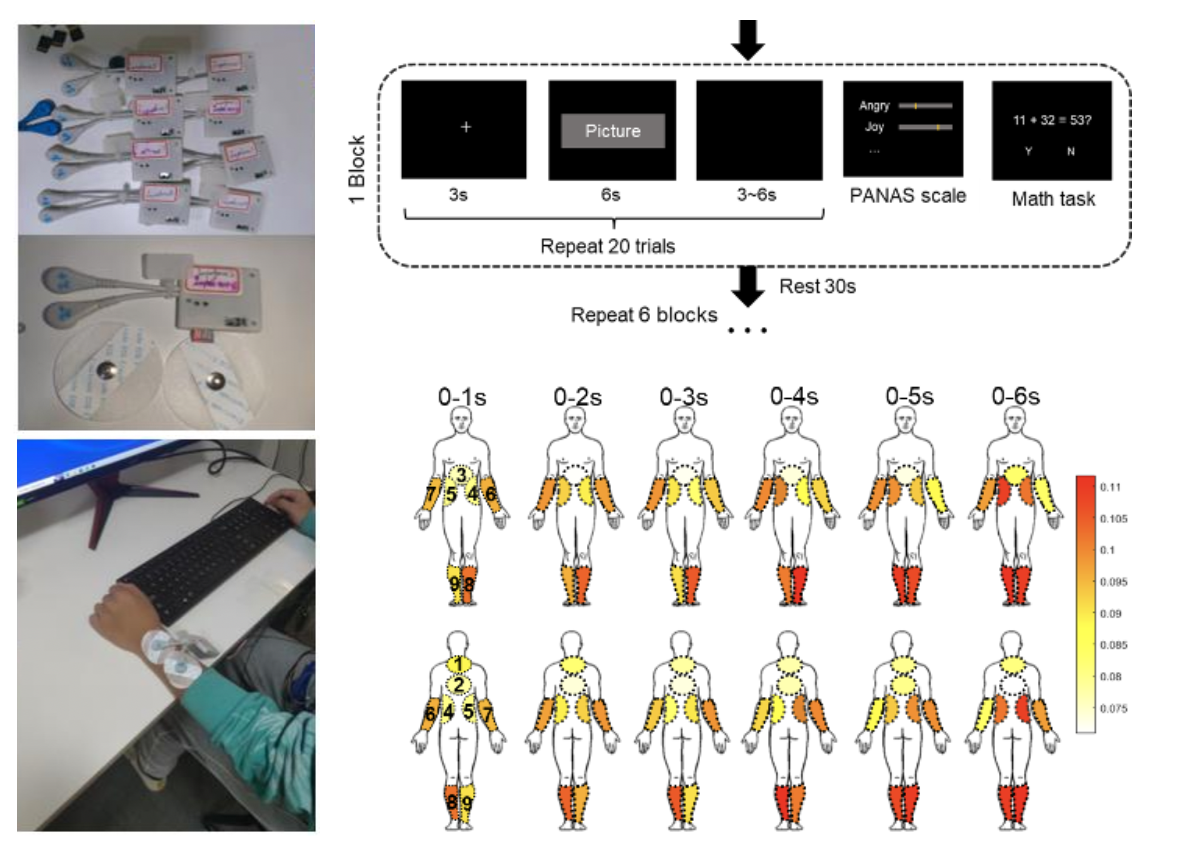The embodied perspective of emotion proposes that emotions are closely related to bodily sensations. Since the publication of the groundbreaking study on how different emotional states correspond to different subjective bodily sensations (Nummenmaa et al., Bodily maps of emotions, PNAS 2014), this field has received widespread attention from academia. However, objective physiological research on emotional bodily expressions has not yet been widely reported. Zhang Dan's research group, in collaboration with Liu Ran's research group from the Department of Biomedical Engineering at Tsinghua University, utilized wearable physiological measurement technology to collect multi-point electrodermal physiological signals from individuals in different emotional states to explore the effectiveness of multi-point electrodermal responses in representing emotional states.

Figure: Multi-point electrodermal sensors (left), emotional image experimental procedure diagram (upper right), and contribution rate of electrodermal response features from different body locations in classifying high vs. low emotional arousal states (lower right)
The research team designed a multi-channel electrodermal measurement device to record skin conductance activity at nine body locations while participants viewed different emotional images (see figure). After extracting electrodermal features from each location, the study found significant differences in electrodermal responses across different body locations. The overall pattern of multi-point electrodermal responses showed significant differences across different levels of emotional arousal and valence. Within-subject classification models based on multi-point electrodermal response features demonstrated that both binary classification of high/low emotional arousal and three-way classification of emotional valence (positive, negative, neutral) could achieve >75% average classification accuracy, demonstrating the feasibility of affective computing based on multi-point electrodermal responses. Compared with traditional electrodermal sensors, the equipment used in this study has excellent potential for lightweight and wearable applications, potentially supporting long-term use in daily life settings and providing new possibilities for everyday affective computing.
This research has been officially accepted and published online in the authoritative journal in affective computing, IEEE Transactions on Affective Computing. The co-first authors of this paper are Shui Xinyu, a doctoral student from the Department of Psychology, and Lin Rongzan, a doctoral student, and Luo Ziyang, a master's student from the Department of Biomedical Engineering. Associate Professor Zhang Dan from the Department of Psychology and Researcher Liu Ran from the Department of Biomedical Engineering are the co-corresponding authors of this paper.
This research was supported by the National Natural Science Foundation of China's General Project (61977041), Tsinghua University Spring Breeze Fund (2021Z99CFY037), and other funds, for which the authors express their gratitude.
Paper Information: Xinyu Shui#, Rongzan Lin#, Ziyang Luo#, Bingxin Lin, Xinxin Mao, Haojie Li, Ran Liu*, Dan Zhang*, "Bodily Electrodermal Representations for Affective Computing," IEEE Transactions on Affective Computing, DOI: 10.1109/TAFFC.2023.3315973.
Paper Link: https://ieeexplore.ieee.org/document/10252022

